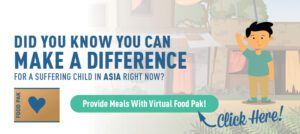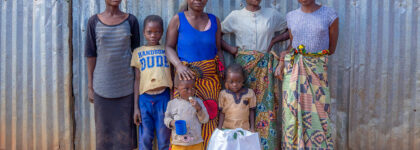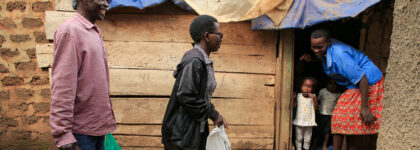In Malawi, nine-year-old Christopher struggles to keep up in school, likely due to cognitive delays caused by ongoing nutritional deficiencies throughout his childhood. In California,…
There are over 109 million people living in the Philippines—that’s over 2½ times the population of California living in an area slightly larger than the state of Arizona. Of the 7,641 islands that make up the Philippines, only about 2,000 of them are inhabited.

A Brief History of the Philippines
In 1521, Portuguese explorer Ferdinand Magellan came to the Philippines Islands on the first voyage around the world, which began in Spain a few years earlier. Although settlers from India, China, and southeastern Asia had already influenced those native to the islands centuries earlier, this was the first European contact with the islands. In 1543, the islands making up the archipelago were given the name Philippines to honor Philip II, who later became the king of Spain.

After over three centuries as a Spanish colony, the Philippines were given to the United States in 1898 following the Spanish-American War. The Philippines became self-governing in 1935, with the promise that they would be fully independent within ten years. This was delayed, however, by World War II and the invasion of Japanese troops. US forces retook the islands in 1944 and granted independence to the Philippines two years later.
The Philippines went through a couple of difficult decades under the corrupt leadership of Ferdinand Marcos beginning in the mid-1960s. Though the economy grew substantially, it was financed by foreign borrowing, leading to a national debt of over $20 billion by 1983. Real incomes of the working class declined drastically as the top ten percent became wealthier.
The Philippines’ next president, Corazon Aquinos, worked hard to revive the economy and address the needs of the poor, but it was not an easy journey. A prolonged drought, a major earthquake, and a typhoon all contributed to an economic decline in 1990.
Natural Disasters in the Philippines
Since 1990, natural disasters in the Philippines have caused over $23 billion in damages.
The Philippines is located along the Pacific Ring of Fire, which traces the boundaries of several tectonic plates, including the Philippine Plate. Ninety percent of the world’s earthquakes happen along the Ring of Fire. In addition, the Philippines has several active volcanos, seven of which are permanently being monitored. Mayon Volcano, on the northeastern island of Albay, is the most active volcano in the Philippines and has experienced major volcanic activity as recently as July 2023.
Because of its location directly in the path of the Pacific typhoon belt, the Philippines is also extremely vulnerable to typhoons. The Philippines is impacted by about 18-20 typhoons every year with about 6-9 storms making landfall. Typhoon season in the Philippines lasts the whole year, peaking from May to November. With these regular storms comes the added danger of flooding and mudslides.

Poverty in the Philippines
Roughly a quarter of the workforce in the Philippines is made up of farmers. Agriculture is the primary source of income for much of the rural population of the Philippines. When agricultural productivity declines due to natural disasters and other causes, these families—many of whom are already living in poverty—are plunged into desperate situations.
The lack of good jobs and adequate education to acquire those jobs has also contributed to the income disparity in the Philippines. When even those with a formal education have difficulty finding employment, their attention begins to turn outward, leading to a widespread Filipino diaspora. Roughly ten percent of Filipinos have left the Philippines to find work overseas. Often, this means leaving children in the Philippines under the care of relatives.
More than a third of the children in the Philippines live in poverty. With little access to nutritious food, this has led to widespread stunting and malnutrition. This combination of poor health and little to no access to proper education means that many of these children will grow up and raise their own children in poverty, continuing the cycle of poverty.

Children’s Hunger Fund in the Philippines
In December 2012, Typhoon Pablo (also known as Typhoon Bopha) made landfall on the southeastern island of Mindanao as a Category 5 super typhoon. Children’s Hunger Fund was able to send a container of food and other relief items to Manila, the capital of the Philippines.
Just eleven months later, Typhoon Yolanda (also known as Typhoon Haiyan) tore through the country, claiming the top spot in the list of the strongest typhoons in the Philippines. Again, Children’s Hunger Fund was able to respond with emergency relief.
In April 2015, Children’s Hunger Fund held a mercy ministry training for pastors and church volunteers on the island of Cebu, establishing a partnership with 17 churches to launch a Mercy Network in the Philippines. The first container of Food Paks arrived in the Philippines two months later.
Over the following years, more and more churches were added to the Mercy Network. More families were being reached with Food Paks and the hope of the gospel. Churches on the neighboring island of Bacolod were also delivering Food Paks and sharing the good news.
In 2018, the Mercy Network was split into two separate networks—one in Cebu, the other in Bacolod. Currently, there are 88 churches in Cebu and Bacolod dedicated to delivering hope to suffering children through gospel-centered mercy ministry.
Please join us in praying for the faithful pastors and church volunteers serving children and families in need in their communities. Every Food Pak and every home visit is an opportunity to build connections and share the love of Christ with suffering families.





